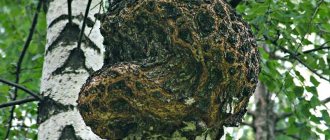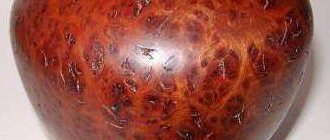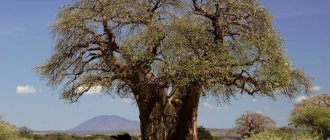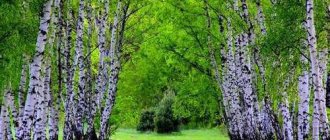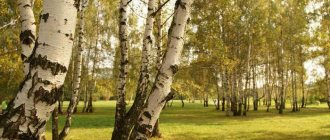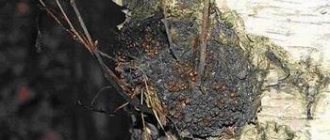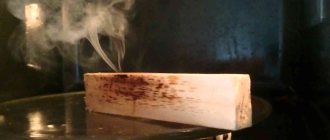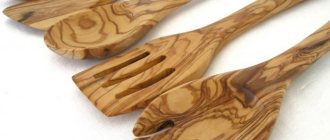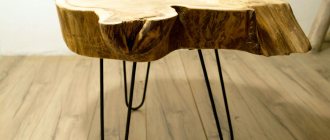What it is?
Suvel is a resource growth for humans, but for the birch itself it does not mean anything good. This growth appears due to a tree disease (figuratively speaking, due to birch cancer). Usually it is a lump, twisted and braided, without a clear geometric shape.
Another popular name for the growth is svil. And this tree grows 2 or even 3 times faster than the tree itself. In shape it resembles either a drop, or a ball, or something in between. The growth is located around a branch or trunk. On birch, such formations are often found, although it is impossible to say exactly what causes them and why they develop. It is believed that suvel appears due to a fungal attack on the tree. But mechanical injury to the birch cannot be ruled out.
But this growth is called woody bone because the cut of suvel resembles marble stains, with a cross-section and rays characteristic of the material, and thin particles of suvel can even be seen right through. Some similarity with the structure of bone tissue can indeed be discerned. True, the tissue density of the growth is still less - this wood is not as strong as, for example, burl.
It happens that suvel grows to enormous sizes. If you come to the Vatican, you can see a font there, which is made from a single piece of souvel cut from a tree. True, gigantic size does not equal quality of material. Typically, the smaller the birch bone, the brighter and more saturated the internal pattern. But in any case, the internal pattern of the growth is soft, without tweezers or needles.
The inside of the suvel resembles mother-of-pearl – in shade, of course. It can be different, it can be whiter, darker, richer or more faded. Sometimes the inside of the suvel is like amber, it can be browner, pinkish or even greenish. What the shade of the inside of the growth will be depends on where the birch grows, as well as on the subsequent drying of this part of the tree.
By the way, suvel can be provoked. Some people simply tie a birch trunk or a specific tree branch with wire. At the site of the constriction, a bulge is formed, which is created by annual rings. But if caring for nature is a priority, you shouldn’t do this.
Suvel is also an advantageous natural formation because it behaves well when processed. The build-up lends itself well to grinding and is perfectly polished. Finally, the main value of education is that very mother-of-pearl cut that resembles marble. It plays with streaks in the sun, captivates with its texture and even gives birth to some kind of inner light. It is impossible to say for sure, looking at a growth on a birch tree, what it is like inside, but certain predictions can be made.
The more clumsy and steeper the growth, the richer and more interesting its internal pattern.
Cap
People call the mouth guard a “witch’s broom.” There really is something repulsive about it, but only if you don’t know what miracle nature has hidden under a thick layer of bark.
What does a cap look like?
Location on the tree Unlike suvel, burls are rare. They usually appear on tree trunks or in the root part. Much less often they form on branches. The basal growths (caporoot) have a flattened shape, while the stem or butt growths more closely resemble a ball, often asymmetrical in appearance. As a rule, the burls are located on one side of the trunk in the form of a characteristic influx; Less common are growths that cover the entire circumference of the tree. There are both single specimens and entire burl colonies covering the tree trunk in small groups.
Formation and structure The fundamental difference between burl and suvel is in the structure. If you look at the burl in cross-section, it will be filled with small woody nodules - these are the so-called dormant buds. While suvel is simply deformed and chaotically intertwined annual rings. Thus, the burl growth represents a kind of reserve bundle of unopened buds, created by nature in reserve. Why exactly? Dendrologists have no consensus on this matter.
Under a thick layer of bark, cap and suvel are practically indistinguishable from each other. The only thing that can give away a burl is the small green branches growing on its surface. This is part of those same dormant buds, only activated for some reason. Without the bark, the difference between burl and suvel becomes obvious. The surface of the burl is covered with cone-shaped convexities, while the suvel is absolutely smooth.
Sizes The sizes of the burls vary greatly: from growths the size of a walnut to truly gigantic formations. The largest documented burl in Russia was found on a flat-leaved birch tree that grew on Sakhalin. Its height was 1.4 m, and its circumference was 10.8 m. The size of the burls depends on the location on the trunk and the type of tree. Root burls are traditionally considered larger, but their extraction becomes a difficult task and is impossible without cutting down the tree. Large burls, weighing 300 kg or more, can often be found on walnuts, downy birch, and Mongolian oak. They grow 3-4 times slower than suvel and are found very rarely.
Texture Burl wood has a characteristic texture, thanks to which it is also quite easy to distinguish it from suvel. On a burl cut, dormant buds seem to be wrapped in numerous layers of wood fibers. Such nodules are somewhat similar to the texture of a “bird’s eye”, but in the mouth guard they are not distributed as evenly. Everything here is chaotic: the buds merge with each other, penetrate each other, are absent in some areas, and accumulate very densely in others. All this creates complex lace abstractions, somewhat reminiscent of a malachite pattern.
READ Why is wood stabilization needed?
Bird's eye (maple wood) and burl texture
The more dormant buds, the more complex and rich the wood pattern. Large burls have fewer buds, so their texture is closer to suvel.
Biological role of mouth guards Both mouth guards and suvel are often called a disease. This position is not entirely scientific, but it cannot be called unequivocally erroneous, at least because the biological role of the growths is still not clear. There are different hypotheses on this matter. For example, the burl is considered as a reserve reserve of buds from which the tree can regenerate, for example, in the event of drought or partial loss of the crown. There is also an opinion that the growths increase the mechanical strength of the trunk, protect it from damage or prevent pathogenic agents from entering it. There are many assumptions, and they are all convincing to varying degrees. However, most dendrologists agree that the ability of trees to form burls has no clear function - it is something of a side effect of evolution that was once more important than it is now.
Birch suvel
A material that has long been known in Russia as wood bone. This is a growth, see photo 1 , (or influx, as it is also called) on Birch, which forms on a tree trunk for various reasons. For example, weather conditions, environmental climatic influences. Also, this effect can be achieved artificially by wrapping the trunk, for example, with wire; over time it will become overgrown with Suvelya. It was called bone because after careful polishing and impregnation with various oils, the wood takes on a bone-like appearance, and its thin parts can be seen through.
Photo 1. View of Suveli after cutting. It looks like a bump or swelling. Initially, it is difficult to judge the internal appearance of wood after cutting it.
In most cases, with proper cutting, you can observe amazing phenomena, namely the interweaving of wood fibers that form pearlescent areas of different (unique) patterns and directions, which literally glow, reflecting daylight. Patterns and colors can be different, mostly pink-yellow, straw, or brownish-yellow with a deep pearlescent glow on the cut; in some cases, there are specimens with a dark brown color with the presence of swamp-green shades. This color range is explained by the fact that the wood grows in different conditions and areas, for example: If the growth was cut down in a very swampy area, then it is possible that the color of the wood will most likely be brownish-green. Or another example: If Suvel is located on the butt part of a tree (the butt part of the trunk is the part that is 10 - 15 cm underground and 15 - 20 cm above it, this is on average) and it is covered with moss, then most likely it it will be dark brown with the presence of a pale pink tint, or straw yellow - golden with dark brown growth rings - that is, the presence of dark shades will dominate, but not always.
Photo 2. A rare and valuable specimen of Suveli, naturally dried for about 1.5 years. In the photo you can see the ray glow of the fibers in daylight. This glow is called “Mother of Pearl”, it can be of different types, from clear pearlescent rays to those that you see in other images, there is no limit to the variety.
Photo 3 . This sample is also rare, its main difference from the one in photo 2 is the marble texture and drying technology, it was dried in a quick way, namely by boiling in a salty solution. The photo clearly shows how it differs from the one in photo 2 , the one above has a total straw or golden color, and in photo 3 the color is predominantly brownish pink.
Photo 4. Here you see a species that is also rare, but is more common than those in photos 2 and 3.
Photo 5. In this photo, mother-of-pearl stains are called ashy or glass. This type is the most common, but its value is not lost because everyone has different tastes. Some people like the radial section, while others like luminous ashy stains.
Photo 6 . This, as we already understood, is the radial direction of the fibers with the presence of ashy stains. (mixed type)
Photo 7 . A specimen that looks like a simple one, but in fact it is not, it is also a rare species that grows mainly in swamps, which is why it has such a color.
Photo 8 . This is an example of how Suvel looks in finished form (product) in combination with reindeer antler and metals. Knife by Valery Sokolov “Svalbard”, made in Scandinavian style.
Also, the general appearance of this wood depends on the type of drying (this does not affect the quality of the products); there are several drying options. 1. Natural, this is when the wood has dried under natural conditions, without human intervention, that is, after cutting over time, the tree has dried out on its own. 2. The old Russian method of quick drying, the wood is boiled in a salty solution for several hours, then the bark is removed and placed in a dark and dry place for several weeks, this is the minimum, and after that it is quite suitable for processing. The noticeable difference after these types of drying is the color. During natural drying, the wood remains its natural color, and after cooking it acquires a soft pink or carrot tint, this is not for everyone, whoever wants it dries it the way he wants. In the skillful hands of a person who has everything in order with imagination, any piece of wood will shine and look expensive, you just have to really want it and use your imagination.
Suvel is a material from which you can make various objects, for example, women's jewelry in the form of pendants, earrings, hairpins and bracelets, it depends on how much imagination a person has. Previously, but no, not only earlier and now some enthusiasts use it to make cutlery that is quite suitable for its intended purpose, take for example the Scandinavian “Kuksy”, this is something like our mugs, only made of wood, a better material than Suvel Can't find one for this. But most importantly, this material is most suitable for making knife handles. Due to its inherent qualities, such as hardness, density, ease of processing and polishing, unique texture, variety of color shades, beauty of mother-of-pearl weaves, etc. One thing is clear that this material will never get boring, although some will disagree with me, this is their right. Previously, I made handles only from exotic types of wood, but they quickly tired me with their monotony and uniformity, although to each their own, and someone will say the opposite. But I definitely learned for myself that there is no better raw material than Birch and what it gives us in the form of Burps, Suvels, Svils, Butts and the root part.
All samples that you see in the form of bars are ground and polished, and then treated with shelf oil. This allows you to preserve the natural color of the wood and protect it from moisture and decay + treated with carnauba wax.
Material used from https://www.zadi.ru
The variety of Suveli is very rich, I would say endless, this material is combined with almost all types of wood, bone, metals, etc.
Burl texture
- The fabulous natural pattern of burl wood consists of:
- Twisted annual layers, usually pronounced
- Pronounced core of small branches
- Curly complex structure
Maple burl
Each burl, like a human fingerprint, has an exclusive pattern and shape. No, in nature there are no two identical growths, called burls. Moreover, neither in the shape of the growth, nor in its structure.
Immediately after cutting the burl, its rich texture is practically invisible. Burl wood reveals its texture to its fullest extent after sanding, polishing and toning.
Birch burl product
- Stem burls have a more refined texture than root burls.
- Processing burls is difficult due to the large presence of knots and twists.
- The burl, after processing, looks like marble or malachite and has a pearlescent sheen.
The color of burl wood can be brown, milky, pinkish, greenish, depending on the type of tree and where it grows.
Suvel
Suvel is growths without dormant buds. Sometimes such formations are called “suvelval” or simply “svil”. Unlike burl, the structure of suvel does not have wood knots, and all the beauty of the texture here is created by chaotically intertwined vessels. From such deformed fibers, an influx in the shape of a ball or drop is formed on the trunk. It grows three to four times faster than burl and is found on trees much more often.
What does suvel look like?
It is quite easy to distinguish suvel from burl. Neither small branches nor buds emerge from it. Under a thick layer of bark, the surface is completely smooth, without conical convexities, like a burl. All the beauty of the texture here is formed by a chaotic strand of intertwined fibers. It does not just flow in light waves, as in some tree species, but gathers into dense folds, bundles, and strands. The beauty of the design is enhanced by a special shimmer that resembles marble, mother-of-pearl or moire pattern. The burl does not have such pronounced overflows.
Suvel changes its appearance more dramatically after finishing. For example, when deeply impregnated with colorless oils and thoroughly polished, wood acquires a special “bone” texture. Because of this, suvel is sometimes even called wood bone. In some rocks, after processing, twisted veins are literally visible through the structure of the material. This effect is highly valued by knifemakers: most often they make knife handles from birch, walnut, and ash.
The density of suvel is lower than that of burl. Moreover, it is an order of magnitude greater than the hardness of stem wood. Processing suvel birch and other species requires certain skills, since, like burl, it is not the most pliable material. But despite all the difficulties, working with him is an incomparable pleasure. Suvel always has a mystery: it is impossible to predict what amazingly beautiful pattern will be revealed after the next pass of the cutter.
Why does a growth called suvel appear?
As a result of external influence on the tree, a fold is formed. Over time, the fold becomes overgrown with tortuous fibers. This is suvel.
There are more suvels on the trees than burls. Under the bark, tree suvels have a smooth surface, and not “pimples”, like burls.
Suveli can have different textures; the predominant shapes include waves, curves, spots, and stripes. After sanding and polishing, the shine and shine of the wood appears.
Suvel ash
Suvel can be of various shades, mainly brown, yellow, gray, slightly greenish, or vice versa with pinkish “notes”
Like mouth guards, suveli can be stem or root. The stem ones are lighter in color and have a less pronounced natural pattern than the root ones.
Burl on the tree
A burl is a growth on a tree with an abnormal wood structure, formed by the local growth of many densely seated accessory dormant buds. Sometimes a few of these hundreds and thousands of undeveloped buds germinate and sprout.
Burl on a tree - ash
The ancient Slavic word “kap” means “head”: usually the growth actually has a rounded shape. Other Old Russian names: bolona, howl, vyplavok, swim, float, howl, paport, roll, goiter, svil, brush. In some sources, burls are also called “witch’s broom” or “whirlwind’s nest,” which is not entirely correct, since these names denote a completely different tree pathology.
Burl forms on all deciduous (mostly) and coniferous trees. In Russian latitudes it can be found on birch, poplar, maple, linden, aspen, oak, ash, elm, and walnut. The dimensions of the burl vary from several centimeters to several meters in cross-section. It takes decades, or even more than half a century, to form a medium-sized growth. Cap is a fairly rare occurrence, and finding at least one specimen in the forest is a great success. However, there are trees with several or even many growths. As well as places with a concentration of burl trees.
Burls on a tree - birch
Typically, trays are divided into stem and root. A trunk burl forms on thick branches or a trunk and can be lateral (develop on one side, most often the south) or circular (grasp a branch or trunk in a ring). A basal growth - caporoot - is formed on the root collar or roots of a tree. In the first case it is above the ground, in the second it is completely hidden and can be detected in the spring by young shoots near the main trunk of the tree, which quickly die. A tree can have different types of burls at the same time.
Caporoot
If you remove the bark from the burl, then under it an uneven, textured surface will be revealed, completely covered with needle-shaped, jagged and pineal-shaped tubercles - these are undeveloped buds.
Burl without bark
Around each dormant bud there is already a rudimentary ring structure.
Dormant buds
How is it different from a mouthguard?
First, it’s worth saying what a cap is. It also has an alternative popular name - “witch’s broom”. This formation, unlike suvel, is of a benign nature. Nodules grow on a birch trunk or branch. This is not some kind of ball or large drop, but a nodular formation, with many cones that create dormant buds (or accessory buds). These formations resemble either spikes or tubercles. It will not be surprising if small shoots and small twigs grow on the burl, right from its insides. With Svil, this is impossible.
The differences between these formations are significant.
For example, a cap is a rare and successful find. It is believed that it can be found on one of 3-5 thousand trees. Suvel is easier to find. On birch trees, people more often find a root burl, and it can also be of impressive size. Processing a burl is not as easy as suvel; nevertheless, the tubercles, bumps and thorns make themselves felt. But there should be no problems with grinding and polishing.
The wood of suvel is not as strong as that of burl. It is at least twice as strong as the birch tree on which the burl grew. Burls are often used to make cigarette cases and boxes, earrings, bracelets, hairpins, and small decor. But a carved pattern on a burl is never created (well, perhaps only by desperate experimenters), because it will be superfluous.
The texture and texture of this rare wood element does not require excessive decoration.
Why does a cap appear?
Researchers have not reached a consensus regarding the reasons for the formation of growths.
The most natural explanation is that the emerging adventitious bud cannot grow through the thick and hard bark and freezes. However, the growth processes that have begun are accompanied by an influx of nutrients to this place and the production of plant hormones, so new buds begin to form nearby, which also become dormant, and so on. Opponents insist that this cannot be done without the influence of external factors of a natural or anthropogenic nature. In particular, mechanical damage to the cortex (animals, birds, people, extreme elements, etc.) at the site of a dormant bud. This assumption is confirmed by the fact that on walnut plantations, where vegetative propagation by grafting (which is actually an injury) is actively used, the root cap often develops on the rootstock below the grafting site. When the fruiting period of the nut expires, the tree is dug up along with the burl, which by that time has grown to a respectable size, and sold as a secondary product.
According to other versions, the formation of burls can be caused by fungi, bacteria, viruses, insects, weather anomalies (such as sudden spring frosts), changes in ecology and background radiation, special mineral composition of the soil, geological faults, and groundwater.
According to the conclusions of Soviet scientists, the formation of burl is a biologically useful, protective property for trees, acquired during the process of evolution in response to unfavorable environmental conditions. Moreover, this is a genetically fixed (hereditary) quality. In the Moscow region and Kirov region, successful attempts were made to cultivate trees with growths using planting material from burl birches (seeds and cuttings for scion). It was noted that such trees are more viable and hardy.
Blank
In nature, suvel is found much more often than kapa. Trees with such lesions can be found in deciduous or mixed forests located in both dry and swampy areas. It must be taken into account that cutting a suvel or burl on a growing birch tree can lead to its death. Therefore, after cutting down the material, it is necessary to cover the living layer with varnish.
READ Wood burning technique for dummies
On dead trees, the formations are already affected by rot and are not suitable for production. Therefore, finding a suitable material for the workpiece is not easy. It is better to do this in mid-autumn.
It is impossible to determine by the type of formation what it will be like in the cut. But the more crooked and tortuous the suvel and the more twigs on the burl, the more saturated the pattern will presumably be. Working with such material is more difficult, but more interesting.
It is quite difficult to cut down suvel and burl, the chains become dull quickly, so good sharpening of the tool is necessary. You can cut it with a hacksaw or bow saw, but this will require a lot of physical effort.
Birch suvel has a different texture when cut. It can be pronounced or completely invisible. Suvel with a texture that is difficult to see usually has higher strength. But you will never guess by the appearance of the growth that there is a cavity or a beautiful ornate bend in it.
Meaning of the word cap
Examples of the use of the word cap in literature.
For callousness,” Alexey narrowed his eyes and spoke in a threateningly mysterious manner, “you will have caps, specialists, and estimates.”
Kapa was carrying a white mug with a bright berry, Liika, bending at the thin waist, was holding a red-haired, fidgety girl, who sullenly clung to the nanny when she saw someone else's uncle.
After traveling around Europe, Kika settled in France, on Cap Ferrat, where the late Eurasianist somehow managed to Europeanize a small villa back in Soviet times.
Then I also remember that when I was walking to the entrance, I was caught by a wave, and I stood on one leg, grabbed the door frame and poured water out of my boot.
He plucked light gray moss and reindeer moss from sandy areas, collected various lichens, birch tinder fungi, agaric mushrooms growing on rotten wood, fancy burls and other gifts of nature.
The strong ties that connected Cap with his father prompted both to engage in lengthy courtship and cajoling, and Tubdu finally gave in - with her good nature it was difficult to resist the desires of three people at once, plus her own attraction to Isako.
In the room there are monks, sisters Angela and Anna, who arrived from Asmara, brothers, sister, Monsignor Kapov and Monsignor Dell'Acqua, Cardinal Cicognani.
A platform was built from logs above the engine hood; we manually dragged powerful pumps onto it.
Mom took out the woolen threads that she bought when she learned to knit and handed them to Capa.
In the spacious planked chamber of the lord's courtyard, bordered by fringed benches, with small mica windows in patterned lead frames, decorated with inserts of blue and red glass, where painted chests with letters and treasury of the house of St. Sophia stand and huge, three-quarters tall, sternly look out from the walls, icons of Novgorod, ancient and Byzantine writing, at an immense oak table, covered with a red, with gold brocade flowers, silk patterned tablecloth and furnished with precious vessels made of silver, gold, painted burl, Venice crystal and glazed oriental glaze with various kvass, light honey and red drinking Fryazhian wine, sit the boyars, gathered from all over the great city.
The music boomed so loudly that Capa cowered in fear and closed her eyes.
When the gray skein ran out, Capa took the red one and tied the thread to a broom, then to a bucket of water.
In the place where Capa was sitting, there was a chair on the floor, sawn in half.
Pavel extended his hands up, but Capa, not paying attention to him, stepped onto the wire.
Olya took a blanket, spread it on the sofa, and laid Kapa on the blanket, like a small child who still cannot walk.
Source: Maxim Moshkov library
Drying
Much depends on how the suvel will be used in the future.
The fibers in suveli are highly intertwined. During drying, stress will inevitably arise, which will lead to splitting and cracks.
How to avoid this? It is necessary to slow down the drying process. So that the inner layers dry evenly along with the outer ones. To do this, you can paint over the cut with paint, drying oil, etc... Drying will occur through the bark. You can fill it with wet sawdust. Under no circumstances should freshly cut suvel be brought into a dry room to dry; keep it in the sun.
Since it will take a long time to dry in such conditions (at least six months), you can boil it in steep brine for 2-3 hours. Or soak for a week. There is less chance that the suvel will rot, turn black, or become moldy. Much has been written about boiling in brine. I won't dwell on this. I did not find any compelling reasons for such a procedure other than to protect against mold. That's why I don't use this method.
After six months or a year (how long does it take?) you can finish drying it indoors.
I don't dry it completely. I saw off immediately into the required pieces with a margin of 1-2 cm. I cut out all the excess to relieve internal tension if it arises. The blanks dry at 10-15 degrees in the shade for 2-3 months. Then I bring the dimensions to my value (grinding, sawing). I'm cleaning the room. Over the course of a year, the workpiece leads strongly, but there are no large cracks.
How to dry birch: suvel and drip
Suvel (the second name for svil) is a special growth on the trunk of some trees. It grows faster than the tree itself and sometimes grows to enormous sizes. It received this name because of the interesting twisted patterns that are unique, like human fingerprints or frost patterns on windows, and therefore valuable.
Birch burls are also growths, but they differ from suveli in shape. Suvel has a twisted structure and a relatively smooth surface, and the cap (another name is witch’s broom) grows in the form of a spherical growth of fibers intertwined inside.
Such growths, after preliminary preparation, are used to create jewelry, amulets and medallions, key rings, decorative interior elements and tableware.
You should go into the forest to hunt for exclusive material at the end of summer - beginning of autumn. The best months for this are August and September. There are no recommendations for searching; you need to inspect all suitable trees on your way; “trophies” of this kind go to only the most attentive.
When you find what you're looking for, don't rush to reach for the saw. Look where the growth is located: if it is on the root or wrapped around the perimeter of the trunk, cutting can seriously damage the tree. In this case, it is worth looking for another copy.
You need to cut off the growths with a sharp thin saw. Do this carefully so as not to damage the bark. After cutting this gift of nature, do not forget to protect the tree and thank it: cover the cut area with wax or oil paint.
Let's move on to the most important thing - the drying method. For this you will need:
- unnecessary large saucepan,
- water,
- salt (you can use discarded salt from the kitchen),
- a handful of pine sawdust.
Pour water into the pan so that it covers our forest finds by several centimeters. Next, add salt - 2 tbsp per liter. l. We wait until the water with pieces of suveli or burl boils, and throw in the sawdust. This is necessary to give the suveli a rich amber hue.
You need to boil water with wood for about 6-8 hours. Then we take it out, wash off the sawdust and leave the souvel alone for two days, without wrapping it in anything. Then we repeat the cooking procedure, reducing the time to 2-4 hours. You can do this with breaks of a day or two two more times. If the bark does not fall off on its own, you need to remove it during the last cooking, not forgetting that the pieces are hot and you need to work carefully.
How to dry a birch burl depends on its size. Cooking is suitable for small pieces; large pieces should be sawn, otherwise they will crack during cooking.
When the blanks are dried, you can begin to create unusual, exclusive items. What it will be - dishes, decorations, decorative elements or a Christmas tree decoration - depends on your imagination and patience.
READ Geometric wood carving for teapots
LiveInternetLiveInternet
Cap, suvel.
Harvesting, drying, properties. The author of this material is a great specialist in the artistic processing of wood (and not only wood), already familiar to us from his carved Easter egg, Sergei from the Moscow region.
Today Sergey will reveal to readers the secret of quick drying of such rare and interesting materials as burl and suvel. The information is very rare and useful. Reading... So first, let's define some concepts. KAP - (aka witch's broom) is a benign formation on a tree, which is a bunch of thin branches growing from a teardrop-shaped (most often) growth. When viewed cross-section, it has a texture with pronounced knot cores. It is difficult to process due to its highly curled texture and a huge number of knots. Extremely beautiful, durable, perfectly sanded and polished. Numerous individual areas have a pearlescent tint. It has no great industrial significance, but is highly valued because of its beauty. If it is used in industry, it is only in the form of veneer for finishing furniture (burls from exotic tree species are mainly used), as well as the production of small products such as boxes, cigarette cases, women's hairpins, and small jewelry (birch burls). Used on knife handles is considered good taste and is also valued by wood carvers for its unique texture. It is impossible to find two identical pieces of burl; even the halves of a sawn burl have different patterns, the build-up is so heterogeneous. It grows on many trees (linden, alder, birch, maple, oak, etc.), but the most valuable and beautiful is birch (of those growing in our latitudes). The growth is usually small, maximum the size of a volleyball ball or the size of a large plate. There is no point in cutting any pattern on the burl, since the texture clogs everything up. The photo shows a birch burl. Unfortunately, I couldn’t get a cut of a birch burl (I took these pictures near my native police station and, as you understand, they wouldn’t let me cut anything down there... But I contrived and found an ash burl; most of the burls are similar in texture and differ only in color and the size of the knots' cores.
SUVEL - (aka svil) As is clear from the name, the growth got its name because of its structure (twisted structure, that’s putting it mildly). Suvel is a drop-shaped or spherical growth on a tree (there is also a ring variety that covers the tree trunk around the perimeter), usually grows 2-3 times faster than the tree itself. When cut, it has a texture similar in pattern to marble and mother-of-pearl (this is the main sign of difference from KAPA; in the future, do not confuse suvel and burl). The presence of mother-of-pearl stains on polished wood creates a beautiful shimmering picture that glows from within. Svil is also poorly processed, like burl, but not as hard. The size varies from a nut to 1.5 meters in height (I myself saw one on a birch) and up to 2 meters in diameter (a ring suvel that completely covered the tree trunk). In the Vatican there is a font much more than a meter in diameter, carved from a single piece of suveli. I myself was once sitting in a chair carved from suveli. It holds fine threads perfectly, but cutting suvel is not recommended. It is better to sand and varnish (impregnate with oil). The product will only benefit from this. The most valuable is the root or butt fork. The presence of dark veins and clearly defined twisted annual rings. This is a fairytale. BEAUTIFUL, that says it all. Barrel suvel has a finer texture and a more subtle “frosty” pattern. And lighter wood. In terms of strength, butt suvel is slightly superior to trunk suvel due to the structure of the tree trunk. Suvel is durable, beautiful, easy to polish and grind. Well-dried and treated, it begins to 'glow' from the inside (with proper impregnation with oils, the wood becomes like amber and even a little transparent). Usually has a color from soft yellow to pinkish-brown to completely ocher-brown. It all depends on the conditions and drying time. The cap has the same colors. Photos: As you can see, the cap doesn’t look like suvel at all. CHAGA is a mushroom (not to be confused with the tinder fungus!!!) and we do not need it for our purposes.
So, how to dry it. I’ll say right away that the “steaming” method is suitable for small pieces of wood. About half the size of a football or a small log. 1. We cut off the growth. We do this with a sharp saw. Otherwise, you will get tired of sawing, and the tree will begin to become shaggy. We do not peel off the bark. Don't forget to cover the cut on the wood with oil paint or wax or something similar. IT IS PREFERABLE TO CUTT OUT THE GROWTH DURING THE DRY TIME OF THE YEAR, IDEAL AT THE END OF AUGUST, THE BEGINNING OF SEPTEMBER, BEFORE THE COMMONATION STARTS. 2. Take an unnecessary pan (bucket) and throw a piece of wood there. The pan is unnecessary, since during the cooking process a very tricky broth is formed which is then very troublesome to wash off. It is better to clean the wood of any rags of birch bark and other fragile and dangling pieces. they will still fall off. I consider birch growth as the most accessible and beautiful; the rest of the growths are cooked using the same technology. The log is accordingly cleaned of any debris and fragile particles. Pour water. It is convenient to do this with a faceted glass (it contains 250 ml). The water should cover the piece of wood by about a centimeter or two. The tree naturally floats up, but let’s press it to the bottom and we’ll see everything. It doesn’t matter what kind of water you pour, cold or hot, it will still boil. You can throw a piece of wood into a saucepan as much as you like; what is important is the volume of an individual piece of wood and not the total volume of wood. 3. Take table salt, whatever you don’t mind. We're not making soup. For a liter of water, pour 2 large tablespoons of salt (who will count glasses of water??? Eh?). You can do more, as much as you like, it’s okay, it’s impossible to overdo it. The main thing is that the water is sickly salty. You can use clean sea water (precisely clean, otherwise it will smell disgusting of mud). The salt will draw sap from the tree, but will not saturate the tree. 4. Find sawdust of resinous wood. Spruce and pine are the easiest to get. Take a saw and go ahead. We need two powerful handfuls of sawdust (raking the sawdust with both hands). Precisely sawdust, not shavings from a simple hand plane. The shavings will come from an electric planer (you can get them at the nearest sawmill or plan them yourself). I always use them. They are quite small and are usually plentiful and easy to obtain. The more resin in the sawdust, the better. And the finer the sawdust, the better. Pour into a saucepan. You could have taken a bigger saucepan! Sawdust will give the suveli a pleasant ocher color. From soft pink-yellow to ocher-brown. Resins will also add strength to the wood and reveal texture. 5. When the water boils, reduce the heat and leave it simmering for 6-8 hours, longer if you have the patience. If the saucepan is large, then you don’t have to turn down the flame, let the water boil and bubble. But you need to watch so that the water does not boil away completely. Salt, sawdust, temperature and time will do their job. Add water as needed. During the cooking process, a red 'broth' is formed. And scale. It is better to remove scale immediately. It is very difficult to wash off. 6. 6-8 hours have passed (depending on the size of the piece of wood). We take out the piece of wood. We rinse under running water to remove sawdust. We dump the water from the pan as unnecessary, but you can leave it for next time if you have somewhere to store it. But it's easier to pour out the water. We throw the growth onto the cabinet, wrapping it in nothing. Let it cool for a day or two. 7 We repeat the cooking and drying process 2-4 times depending on the volume of the wood. To speed up the process, you can use a pressure cooker. The time is reduced to 4-6 hours. 8. During the last cooking, you need to quickly peel off the bark while the tree is hot. Although she herself should fall off by this time. Carefully!!! Hot!!! use gloves! 9. We throw it on the closet for a week or two. The tree is basically already dry, but let the remaining moisture go away. The tree will 'get used' to the atmosphere. After final drying, the wood will become bone-like and can be cut, sawed, or sanded. There will be no foreign smell. It will only smell like wood. 10. In the process of accelerated drying of wood, it must be remembered that small cracks may appear, and therefore it is necessary to allow allowance for their removal in subsequent processing. 11. Where to look for growths... Naturally in the forest. BUT! There are no specific places of growth, they grow spontaneously, and the biggest and most beautiful growths will be found by the most big-eyed and persistent. This activity is akin to mushroom hunting; whoever ran around the forest further and further got more. Look like that's it. I remind you once again that large pieces cannot be dried like this. Cracked. Necessarily. Verified. 12. After the wood has finally gotten used to the atmosphere, you can start working with the workpiece. It is advisable to soak the suvel and cap with oil, and if desired, with wax too. The wood will reveal its texture, it will “play,” as they say, and all its inner beauty will appear. If you have any questions or any clarifications about the technology described above, I will answer to the best of my ability. I’ll end with this, your Serjant.
[\MORE]
Treatment
The simplest option is to make utensils from suveli, just as nature intended. In this case, we will remove the bark and select cavities while the suvel is damp and has not cracked. You can make holes with a drill in the volume that will be removed and left to dry. In its raw form, the workpiece is easier to cut. We make cuts along the grain. Let it dry for half a year. Next we do the final revision.
Since the cuts go along the grain, the texture does not stand out much. But the dishes turn out to be very durable.
Mouth guards and suveli: use
The use of burls and suvels is primarily decorative. Of course, they are used to make functional things, but even their main task is to please the eye, and not to be something purely utilitarian.
Burls and suveli are rarely used in carving. Their extremely bright texture “eats” the entire carving. In addition, the carving looks cheap on expensive material. As a rule, craftsmen simply grind the material and impregnate it with oil or varnish it.
Suveli and mouth guards are not used on an industrial scale. Previously, in Russia, more precisely, back in the USSR, there were several enterprises whose workers created masterpieces from suvels and caps. Now these unique creations of nature are going, roughly speaking, into the furnace. For foresters, growths are simply a defect in the wood, a defect in the material.
So, what are the types of products made from burl and suvel?
We will conditionally divide them into three groups – decorative products, functional products and veneer.
1) Decorative items made of burl and suvel. It can even be burl or suvel in its natural form, just without bark and varnished - an excellent decor for an eco-style home.
A special place is occupied by sculptures and figurines, especially those depicting animals. Why animals? The texture of burls and suveli perfectly imitate the plumage of birds, wool or animal skin. In addition, the natural smooth lines of this material themselves suggest what they can become - all that remains is to remove the excess. But mouth guards and suveli are not suitable for depicting human faces, as they give them an unhealthy appearance.
Burl products
Another product made from burl and suvel is panels. Burls and suveli are such a unique material that it is enough to choose the right tint - and the real picture is ready. However, such material is used in mosaic, marquetry and intarsia.
And, of course, the beautiful texture looks great on hairpins, keychains, pendants, cufflinks and other jewelry. And bowls, vases, stands and candlesticks will give any home a feeling of luxury and real taste.
2) Functional items made from mouthguard and suvel. This can be small furniture, dishes, boxes, snuff boxes, tool handles, office supplies, lamps, frames, chess, canes, watches and much, much more. Of course, such things fulfill not so much their functional requirements as their decorative ones. Functional items made from suvel and burl say a lot about the excellent taste of their owner.
Computer mouse made from Karelian birch burl
– Burl or suvel veneer. The same objects that are made from solid wood can be veneered with burl or suvel veneer - watches, frames, furniture, car parts, work accessories, and so on. Veneer, as a rule, is made to match the burls of exotic tree species.
Burls and suveli are perfectly combined with metals, mother of pearl, and bone.
Karelian birch, burl and suvel - what's the difference?
KARELIAN BIRCH
Karelian birch is one of the calling cards of our region, along with Kizhi, Valaam, shungite, cloudberries and wickets. Many who visit Karelia choose products made from “Karelian birch” as a souvenir. At one time I had the opportunity to work in the field of selling souvenirs, and in a prominent place in the store there hung a huge clock made of sawn wood, with a diameter of about 60 centimeters, no less. And every day there was a dialogue between me and the guests of the republic:
- ABOUT! And this is your famous Karelian birch! — the potential buyer is delighted.
“No, this is our no less famous Karelian pine,” I humbly answer.
Not all ornamental wood in Karelia is “Karelian birch”. Moreover, I’ll tell you a secret - for the extraction and felling of “Karelian birch” in Karelia, considerable fines are imposed, in nature this tree is rare, dealing with it is a troublesome business and you won’t end up with problems later.
The entire souvenir industry of the “Karelian birch” says thanks to the nurseries in Belarus, where this tree is bred purposefully - to obtain wood on an industrial scale, which is highly valued and sold by weight. Then, three-dimensional products are cut from it, used on thin veneer for pasting boxes and picture frames, etc. You can’t really go wild - the diameter of the “Karelian birch” usually does not exceed 20-25 cm. This is because the “Karelian birch” is not a separate species, but an anomalous form that is found in ordinary silver birch, under a rare combination of circumstances. Such a weakened, diseased tree lives a little more than 40-60 years, so, as a rule, it does not have time to grow large. Scientists are still arguing about the reasons for the appearance of the patterned wood texture of this mysterious tree.
This is what this tree looks like in nature (photo from the Kivach nature reserve in Karelia):
And this is a drawing of a cross-section of this rare variety of birch:
As we can see, the wood is very beautiful, dense, with a pronounced pattern, a kind of “wood marble”.
In addition to the anomaly called “Karelian birch,” birches delight us with such quirks of wood growth as burl and suvel. About them in order.
BIRCH CAP
Birch burl is a formation on a trunk or branch with a large number of woody nodules. These small (20-30 cm in diameter) formations look like dark spikes and tubercles; often on the burl you can see small shoots and twigs growing directly from it. The wood of a burl is 50-70 percent stronger than that of the tree on which it was formed.
This is the outside view:
Such beauty is hidden in burl wood. It is very easy to confuse with the “Karelian birch” pattern:
SUVEL BIRCH
The formation of suvel is caused by a tree disease and most often it is a twisted and woven growth in a lump. Outwardly it looks like this, but can reach impressive sizes:
Suvel usually grows two to three times faster than the tree itself and has a teardrop-shaped or spherical shape located around the trunk or branch. The main difference between suvel and burl is that suvel is formed not from dormant buds, but due to the interweaving of annual rings curved in different directions.
The difference between suvel and “Karelian birch” and birch burl is the absence of clearly defined dark patterns, a larger cut size, and the pearlescent shimmer of the wood:
EPILOGUE
So, we briefly examined the features and differences of “Karelian birch”, burl and suvel. Unscrupulous manufacturers often take advantage of the buyer's ignorance of the quality and appearance of wood, so be careful when making a purchase. How to avoid becoming a victim of deception? Let's take an example from the web:
The manufacturer states that the painting is made of Karelian birch material. But in this section we do not see the characteristic “Karelka” pattern - pronounced patterns and lines. Further, a rather large cut size of 35 x 28 cm is stated, which is also not typical for “Karelian birch” (remember, its diameter rarely exceeds 25 cm). Well, the description of the work “burning on a burl” completes the picture - the writer needs to decide, after all, on a burl or on a “Karelian birch”?! In all likelihood, this is an ordinary cut of birch of irregular shape.
Thank you for your attention!)
